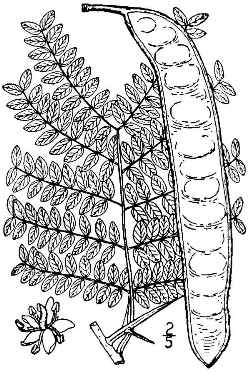
Britton, N.L., and A. Brown. 1913. Illustrated flora of the northern states and Canada. Vol. 2: 339. Courtesy of Kentucky Native Plant Society.
Sunset®: 1-16,18-20
USDA: 3-10
Sun Exposure: Full sun
Origin: East-Central United States
Growth Habits: Deciduous tree, moderately fast growing to 50 to 100 feet tall (15-30 m) or more; thorny trunk and lower branches; the leaves are 6 to 8 inches long (15-20 cm), pinnately compound with 15 to 30 leaflets or bipinnately compound with 4 to 7 pairs of pinnae
Flowers: Greenish flowers
Watering Needs: Little to moderate water
Propagation: Seeds, grafting, budding, and cuttings (hardwood, softwood, and root cuttings)
Propagation: Seed
- by seeds. Germinates at 70-85 degrees F. The seeds can be harvested in autumn. The seeds need scarification. The usual germination temperature is 70-85 degrees F.
Unlike most leguminous species, honey-locust does not form Rhizobium nodules on its roots, and does not fix nitrogen
Blooming Habits:
Very fragrant white-green flowers, on 2 inch long racemes, from May to June, after the leaves are nearly full grown. The fruit is a 8 to 16 inches long (15-40 cm) and 1 to 1.4 inches wide (2.5-3.5 cm) flattened, red-brown pod
Propagation:
Seeds should be scarified (both hot water and acid treatments are effective)
Desert-Tropicals is dedicated to provide gardening advice, gardening ideas, and information about flower of all kind for landscape and collections.We try to check carefully the identification of the plants on the illustrations as well as the other information from the page, but occasionally errors do occur. if you notice anything that needs to be changed please contact us.Thanks.
© 1998-2020 Philippe Faucon, All Rights Reserved.